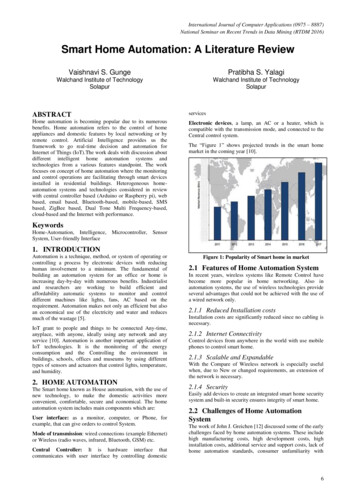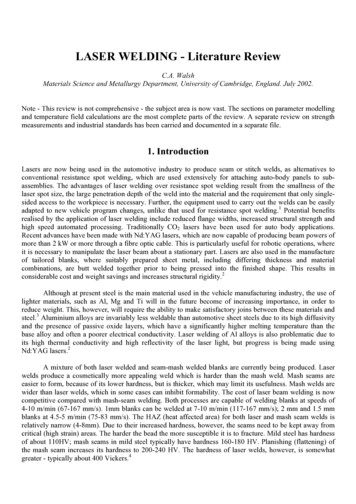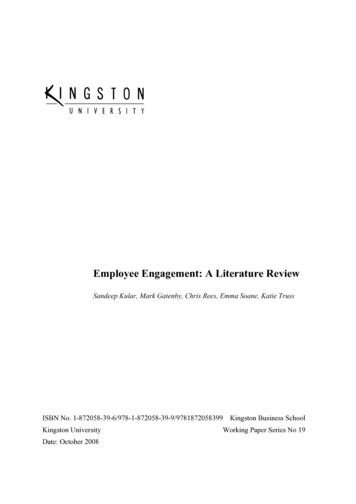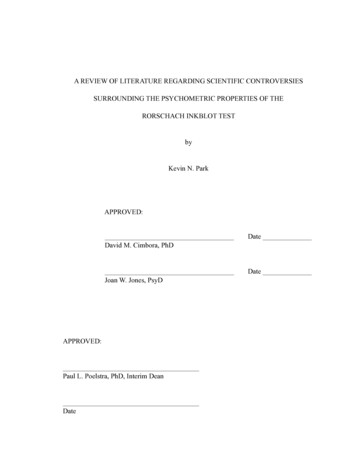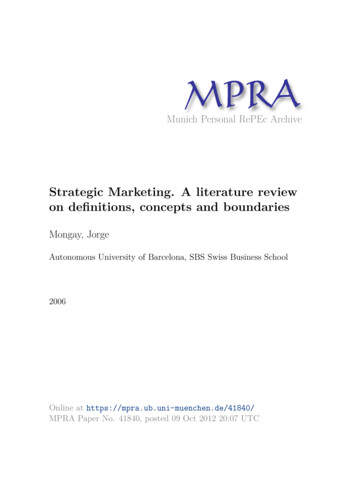
Transcription
Munich Personal RePEc ArchiveStrategic Marketing. A literature reviewon definitions, concepts and boundariesMongay, JorgeAutonomous University of Barcelona, SBS Swiss Business School2006Online at https://mpra.ub.uni-muenchen.de/41840/MPRA Paper No. 41840, posted 09 Oct 2012 20:07 UTC
WORKING PAPER. JM-A1-2006STRATEGIC MARKETING:A LITERATURE REVIEW ON DEFINITIONS,CONCEPTS AND BOUNDARIES.Dr. Jorge MongayAutonomous University of Barcelona (UAB)&SBS Swiss Business School1
WORKING PAPER. JM-A1-2006Summary1. Definitions of strategic marketing2. Aspects of Strategic Marketing3. Factors in Strategic Marketing4. Elements of Marketing Strategy5. Intersections with others disciplines5.1.Intersection between Strategic Marketing and Marketing Tactics5.2.Intersection between Strategic Marketing and Corporate Strategy5.3.How does it Strategic Marketing fit into Corporate Strategy?6. Final conclusions of the paper7. References2
WORKING PAPER. JM-A1-20061. STRATEGIC MARKETING AND ITS DEFINITIONSAlthough most authors speak about some parts of Strategic Marketing, here isincluded a list of definitions of the term. Some authors appear in different years (for example, Jain), It is understand that they have added new comments orredefined the term after the years. The table and the definitions have been orderedby year of publication.AuthorYearDefinitionDrucker1973“ Strategic marketing as seen as a process consisting of:analyzing environmental, market competitive and businessfactors affecting the corporation and its business units,identifyingmarket opportunities and threats and forecastingfuture trends in business areas of interest for the enterprise corporate and business unit strategies. Selecting market targetstrategies for the product-markets in each business unit,establishing marketing objectivesimplementingandmanagingas well as developing ,themarketingprogrampositioning strategies in order to meet market target needs”.Hart&1977Stapleton" a statement in very general terms of how the marketingobjective is to be achieved, e.g. acquiring a competitivecompany, by price reductions, by product improvement, or byintensive advertising.The strategy becomes the basis of themarketing plan"Lambin1977“The role of strategic marketing is to lead the firm towardsattractive economic opportunities, that is, opportunities thatare adapted to its resources and know how and offer apotential for growth and profitability”.Baker1984“the establishment of the goal or purpose of a strategicbusiness unit and the means by which it is to be achievedtrough management of the marketing tuationorganization is an essential startingconfrontinganpoint in developing amarketing strategy”Hamper &1990“Although definitions for the term vary, we define marketing3
WORKING PAPER. JM-A1-2006Baughstrategyas a consistent, appropriate and feasible set ofprinciples through which a particular company hopes toachieve its long-run customer and profit objectives in aparticular competitive environment”.Aramario1991“ although marketing has basically an strategic conception ofthe selling activity, we use to distinguish between strategic& Lambinmarketing and operational marketing, depending on long ational analysis and possible evolution of the markets andthe environment, with the goal of detecting opportunitieswhich can establish objectives”Schnaars1991“There is no unified definition upon which marketers agree.Instead, there are nearly as many definitions of it as there areuses of the term. Clearly, marketing strategy is a commonlyused term, but no one is really sure what it means”.Bradley1991" the strategic marketing process, therefore implies decidingthe marketing strategy based on a set of objectives , targetmarket segments, positioning and policies"Walker,1992“ The primary purpose of a marketing strategy is to effectivelyBoyd,allocate and coordinate marketing resources and activities toLarrechéaccomplish the firm’s objectives within a specific productmarket. Therefore decisions about the scope of a marketingstrategy involve specifying the target-market segment(s) to bepursued and the product line to be offered. Then, firms seek acompetitive advantage and synergy, planning a well integratedprogram of marketing mix elements.”Jain1993“Marketing strategy is mainly indicated by the marketing4
WORKING PAPER. /market momentumperspectives( i.e. extrapolationandof pastperformance to the future), form the basis of marketingstrategy”. “Marketing strategy is developed at thebusiness unit level. Within a given environment, marketingstrategy deals essentially with the interplay of three forcesknown as the strategic 3 C’s: the Customer, the Competitionand the Corporation.A good marketing strategy should be characterized by a) clearmarketdefinition, b) a good matchbetweencorporatestrengths and the needs of the market and c) superiorperformance, relative to the competition, in the key successfactors of the business.Marketing strategy, in terms of these key constituents, mustbe defined as a n endeavour by a corporation to ingitsrelativecorporate strengths to better satisfy customer needs in a givenenvironmental setting.Based on the interplay of the strategic three C’s, formation ofmarketing strategy requires the following 4 decisions:1. Where to compete. (definition of the market). One orvarious segments 2. How to compete, that is, it requires a means forcompeting .3. When to compete, that is, it requires timing of marketentry. “In its strategic role, marketing focuses on abusiness’s intentions in a market and the means and timing ofrealizing those intentions. The strategic role of marketing isquite different from marketing management which deals withdeveloping, implementing and directing programs to betweenmarketing management and marketing in its new role , a term-strategic marketing.- has been coined to represent the latter”.5
WORKING PAPER. JM-A1-2006“Strategy which defines the general principles for reachingCamara1995objectives related to the specific SBU’s and target markets. Itcontains the main directives of the marketing expenditure,marketing actions, and resource allocation in this area. Itincludes decisions like: segmentation strategies, positioning,communication. The definition of marketing strategies referringto the marketing plan : it is one of the sections which integratethe marketing plan and its own objective is to present anaction plan which will be utilised to reach the marketing planobjectives.”Bennet1995" the process of planning and executing the conception ,pricing , promotion and distribution of ideas, goods andservices to create exchanges that satisfy individual andorganizational goals."Sudharsan1995“Marketing strategy creates pathways to a desirable future.The output form such marketing strategy analysis and choice (or strategic marketing decision ) is a marketing strategystatement”.Kotler1997“the selection of target markets, the marketing mix and themarketing expenditure levels”. “The marketing strategy isthe way in which the marketing function organises its activitiesto achieve a profitable growth in sales at a marketing mixlevel” . “A marketing strategy may be defined as a plan (usually long term) to achieve the organisation’s objectives asfollows ”a) By specifying what resources should be allocated tomarketing.b) By specifying how these resources should be used to takeadvantage of opportunities which are expected to arise in thefuture.“a marketing strategy would consist of the following:a. Identifying markets and customers needs in those6
WORKING PAPER. JM-A1-2006markets.b. Planning products which will satisfy the needs of thesemarkets.c. Organising marketing resources , so as to matchproducts with customers in the most efficient andeffective way possible, ie, so as to maximise customersatisfaction and the organisations profits or salesrevenue. (or whatever its objectives are !) at the sametime”.Munuera1998“ A methodology of analysis which pretends the knowledge of&customers needs and the forecast of potential options ( oursRodriguezand competitors) in order to gain competitive advantage in along term ( sustainable ) and defendable”.“the term “marketing strategy” reflects the company’s bestMcDonald1999opinion as to how it can most profitably apply its skills andresources to the marketplace. It is inevitable broad in scope.Marketing strategies are the means by which a companyachieves its marketing objectives and are usually concernedwith the 4 p’s”.Jain2000“Strategic marketing means looking at the whole of acompany’s portfolio of products and markets, and managingthe portfolio to achieve the company’s overall goals”Bradley2003A marketing strategy consists of an internationally integratedbut externally focused set of choices about the organisationaddresses its customers in the context of a competitiveenvironment.Keeping in mind all the definitions founded, I specially find interesting the oneoffered by Hamper and Baugh in 1990, which says: "although the definitions of theterm vary (that is to say, its assumed that a certain flexibility exists in the term),this it is a consistent term (it should be based on generating future strategic solid7
WORKING PAPER. JM-A1-2006plans), appropriate group of principles through those that a company hopes (theterm implies the uncertainty and the risk implicitly) to reach objectives long termrelated with the clients (the client becomes a strategic factor to keep in mind,although was not this way in the years 1960 or 1970 s) and the objectives ofprofitability (profitability is alsostrategically important) , in a competitiveenvironment in particular” (that is to say, it’s assumed that each case should beanalyzed under specific circumstances, being able to create general and modelrules, which will have generic applications but non in particular).After analyzing the definitions of the most well known authors, it is necessary tosay that they could be grouped in two generic groups since all do not agree in theterms of the definitions, or approaches.This classification includes a first group denominated “classic” approach, formedby those theoreticians who maintain a clear homogenization on the term, itsdefinition and its characteristics. (Druker 1973, Bradley 1991, Bennet 1995,Camara, 1995, Baker 1984, Walker, Boyd and Larreché 1992, Harper and Baugh1990, Lambin 1977, Jain 2000, Kotler 1997, Aramario and Lambin 1991, Bradley1991.) It seems to be that this group agrees in its definitions existing only somesimple adaptations over the time.On the other hand the rest of authors diverge in their definitions although theydiffer not clearly with the previous ones, we could say that they are a little daringat the time of raising definitions relative to strategic marketing. This classificationcan be called as “alternative” since it is not in the same line that the previousone.Considering these differences I have decided to separate two groups of thought inthe area of strategic marketing, the one of “classic” and the other calledthe“alternative ones”.The classic line of thought:The classic line part of premises such as that strategic marketing is associated toprocesses (Druker, 1973, Bradley 1991) relative to the planning and the executionof the plans looking for, as a primary target, satisfying the needs of the individualsand the organizations clients (Bennet 1995). Strategic marketing has direct8
WORKING PAPER. JM-A1-2006relationship with the management of Strategic Business Units or SBU' s, (Baker,1984), that is to say, that is managed at a level of business, ( non-corporate) andit communicates directly with the functional strategy of marketing, being defined bya set of basic principles which explain the main decisions and directives ofperformance of the company, it manages the cost level and budgets for marketingactions and its in charge to allocate resources on the basis of needs, as well as tointegrate the strategy of marketing within the set of the marketing plan (Camera,1995). Strategic Marketing also should define subjects related to the coordinationof the marketing resources, as well as to the allocation of such referring to theimportance of the competitive advantage (Walter, Boyd and Larreché, 1992). Theterm includes a set of principles which would have to be appropriate and to beoriented to the long term (Harper & Baugh, 1990), in this “appropriate” case isunderstood to make decisions guessed “right and coherent” for the attainment ofgiven marketing objectives. This classic approach also makes reference to the“opportunities” (Lambin, 1977), these opportunities are those potential possibilitiesat which the company arrives at through an external analysis. Strategic Marketingshould be centred in the integral management of products and markets with theaim to reach the objectives previously set (Jain 2000). The selection oftheobjective markets as well as a plan (generally in the long term) to arrive at thecorporative objectives, allocating resources efficiently, without forgetting toconsider detecting business opportunities and satisfying the customer needs(Kotler, 1997). Once again this approach presents a clear direction towards theplanning systems.Strategic marketing separates and differentiates mainly fromoperative marketing in the related management with “time”, since the strategic oneis oriented to the attainment of long term objectives, the possible evolution of themarkets and oriented to detected opportunities (Aramario & Lambin, 1991). Theterm is also clearly associated to the “objectives”, related to the processes ofstrategic marketing
pricing , promotion and distribution of ideas, goods and services to create exchanges that satisfy individual and organizational goals." Sudharsan 1995 “Marketing strategy creates pathways to a desirable future. The output form such marketing strategy analysis and choice ( or strategic marketing decision ) is a marketing strategy statement”. Kotler 1997 “the selection of target markets .




